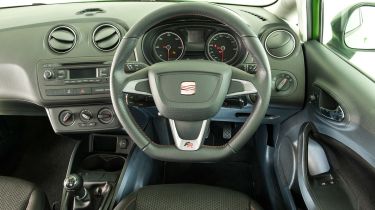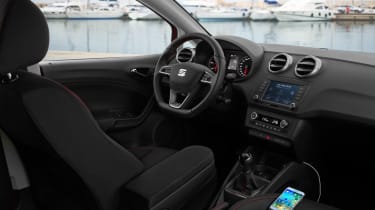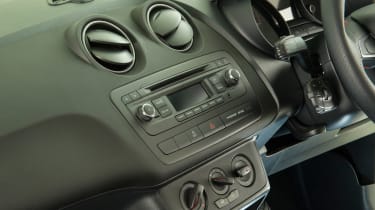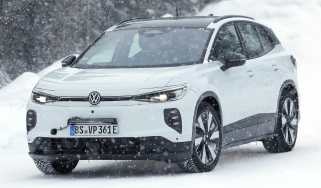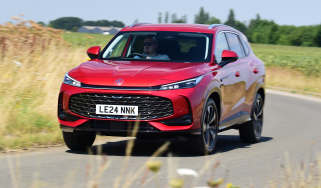Used SEAT Ibiza (Mk4, 2008-2017) - How practical is it?
There’s a wide range of body styles, but the Ibiza’s eye-catching looks have an effect on its practicality
Most superminis live a double life - urban runaround one minute and occasional family car stand-in the next. Overall, the Ibiza does a good job of handling both tasks, especially the five-door and ST estate. Yet its rakish good looks do create some restrictions, particularly for those sitting in the back. Overall it’s very well-equipped and promises to be a safe choice.
Dimensions and cabin design
The dimensions tell you a lot about why the SEAT Ibiza trails some rivals on interior space. Perhaps surprisingly, at 4,061mm it’s longer than its similar era Skoda Fabia sister car. It’s a little narrower than the Fabia and the same age Hyundai i20, but it’s the height that really gives the game away. The sleek-looking SEAT has a roof height of 1,445mm, while the Hyundai and Skoda stand taller at 1,474mm and 1,467mm respectively.
Despite the addition of two extra doors, there isn't much difference in terms of space between the three-door SEAT Ibiza SC and the standard five-door Ibiza hatch. But if you need more room, the Ibiza ST estate is a practical option that retains its sense of style.
Space up front for the driver and passenger is decent in all bodystyles, but the Ibiza is not one of the class leaders on the practicality front – even the glovebox and door pockets seem a little on the cramped side.
There’s also a price to be paid for the Ibiza’s rakish roofline. Even in five-door guise, adults will find the back seats cramped, so if you really need to carry passengers any significant distance, you’ll be better off looking at cars like the Hyundai i20 or the Skoda Fabia.
Used - available now

2023 Seat
Ibiza
24,820 milesManualPetrol1.0L
Cash £13,095
2024 Seat
Ibiza
6,035 milesManualPetrol1.0L
Cash £14,349
2024 Seat
Ibiza
18,705 milesAutomaticPetrol1.0L
Cash £15,441
2021 Seat
Ibiza
24,738 milesManualPetrol1.0L
Cash £12,198The problem is exacerbated in the three-door SC because it’s pretty awkward to get into the back seats in the first place. Once you’re there, the main issue is the limited headroom, so this criticism will be less relevant to those with young families. Isofix child seat mountings are standard.
The interior layout is modern and clean, particularly on post 2015 models that got a colour touchscreen replacing the previous model’s array of buttons and dials. The instrument display is also attractive and clear, with white-on-black dials, and the round vents help to give the cabin a sporty feel.
Early cars aren’t quite as robustly put together, however, with more use of hard and scratchy plastics. A facelift in 2012 brought some quality improvements, but the most upmarket feeling are the cars built from 2015 onwards.
SEAT has a tradition of allowing customers to make a bold style statement through vivid colour and trim choices, and the Ibiza doesn’t disappoint in this regard. Colour Packs brought ‘colour-coded’ shades such as purple, blue, red or grey to the radiator grille rim and wing mirror housings, as well as to the interior vent bezels and detailing on the steering wheel and gear lever. You could even specify twin-colour 16-inch or 17-inch alloy wheels so there will be some lively-looking Ibizas out there on the used market.
Boot space
With the rear seats in place, the SEAT Ibiza SC has a boot capacity of 284-litres, which is only marginally less than the 292-litres in the five-door. When you fold the seats, both versions serve up the same 847-litre maximum space.
This is about average for the supermini class, and will be fine for day-to-day tasks. But if you want even more room, the Ibiza ST estate offers 430-litres of space with its rear bench in place, and 1,164 litres when it’s folded.
Equipment and technology
In the 2015 facelift, SEAT fitted its second generation of its Easy Connect infotainment set-up. With the MediaSystem plus, you can upgrade to MirrorLink and integrate your smartphone; the technology is compatible with Android Auto and Apple CarPlay. DAB radio is available, and you can play music via USB or Bluetooth connections. MediaSystem plus also adds voice control.
In addition, there was also the chance to upgrade to the SEAT Sound System, which in the Ibiza brings six speakers, a subwoofer in the boot and an extra amplifier. Earlier cars get a more basic infotainment set-up, with a traditional in-dash radio and CD player set-up. Most got Bluetooth and a 3.5mm AUX-in socket for external music players, but check the specification carefully as entry-level models usually missed out.
SEAT offered six trim levels across the Ibiza range, kicking off with the basic E, which is a three-door SC with a single engine option. From there, buyers could move up through S A/C to mid-range SE spec, and Connect versions with the full infotainment package. There’s a sporty SEAT Ibiza FR model, which provided a stepping-stone up to the 178bhp Cupra. Various special editions were offered from time to time and these are worth looking out for.
The entry-level SEAT Ibiza spec sheet is pretty lack-lustre, as the Ibiza E comes on steel wheels with hubcaps. On the post 2015 cars you got a five-inch (black and white) touchscreen, with a USB port and four-speaker stereo though. Even on the S A/C alloys wheels are optional, but air-con is standard and, on later models, Bluetooth connection and DAB radio.
Alloy wheels arrive with SE spec, as does cruise control and powered and heated door mirrors. Again the post 2015 model is worth seeking out as the upgraded colour touchscreen system. For buyers wanting the best tech, the Connect editions bring Internet connectivity, MirrorLink and Apple CarPlay among a feast of infotainment upgrades.
The FR package adds sports suspension and a wealth of racy trim enhancements inside and out. It’s a similar story with the Cupra, which is distinguished by its black front grille surround, bigger alloys and upgraded brakes.
Safety
The Ibiza was tested twice by EuroNCAP; first in 2008 and again in 2011, after its first update. On both occasions it scored the full five stars, but it’s worth bearing in mind the test has become more challenging over the years. For instance, the original cars only had four airbags to the later cars’ six, while electronic stability control only became standard across the range in 2012.
Options on the post 2015 cars include city brake assist and lane-keeping assist, and a Tiredness Recognition System designed to spot the signs if drivers are nodding off at the wheel and sound an alarm. Also added is Multi-Collision Brake, which automatically slows the car following an impact serious enough to activate the airbag – it works by setting the ESP system to apply the brakes.
